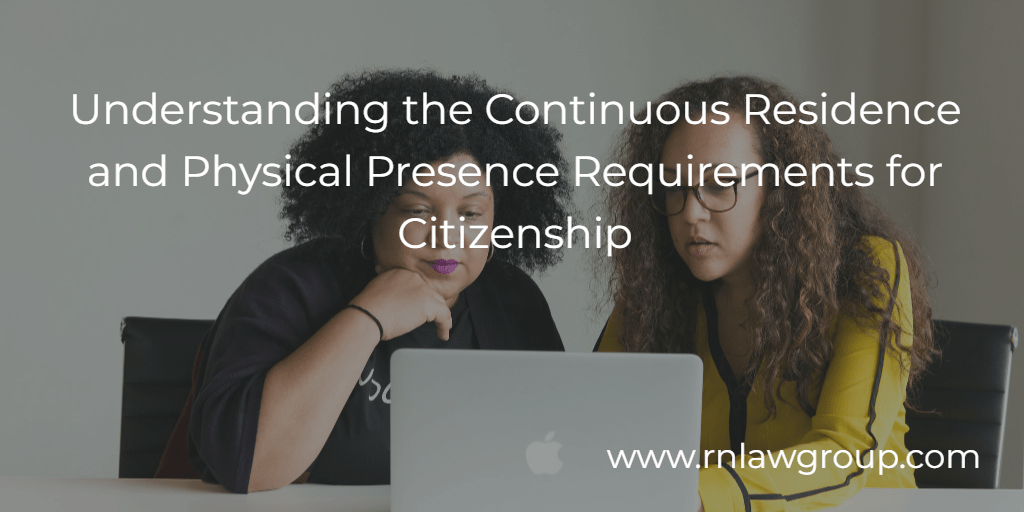
Understanding the Continuous Residence and Physical Presence Requirements for Citizenship
Applying for citizenship in the United States is a significant milestone for lawful permanent residents (LPRs or green card holders) seeking to reach the pinnacle of their American immigration journey. However, this process entails meeting certain eligibility criteria, including fulfilling presence requirements that must be showing when applying for the N-400. Central to this process are two specific requirements, the continuous residence and physical presence requirements, which serve as vital benchmarks in determining an applicant’s commitment to becoming a citizen. Understanding these requirements, including exceptions and nuances, is crucial for prospective applicants navigating the path to naturalization. As people continue to get their green cards and look to plan the next steps in their immigration journey, it is important to understand the physical presence and continuous residence requirements so as to not potentially jeopardize your citizenship.
Difference between Qualified Spouses of US Citizens and Others
One notable distinction in the naturalization process pertains to qualified spouses of US citizens. The Immigration and Nationality Act (INA) provides certain exemptions and accommodations for spouses of US citizens, recognizing the unique circumstances they may encounter. For example, there is a distinction as to the length of time you have to wait to file for citizenship after achieving lawful permanent residency. While most LPRs must wait five years, those that have US spouses and a green card through marriage only have to wait three years to apply for citizenship. This naturally changes the calculus for the presence requirements. The rules are nearly identical for both categories, with just slight differences in the timing requirements.
Difference between Continuous Residence and Physical Presence Requirements
Continuous residence and physical presence are fundamental components of the naturalization process, each serving distinct purposes in evaluating an applicant’s eligibility. While they may sound similar, they are both unique elements to the naturalization application process and both must be considered.
Continuous residence refers to the uninterrupted period of time a lawful permanent resident has resided in the United States before filing Form N-400. This requirement seeks to assess an individual’s commitment to establishing roots and integrating into American society over an extended period. USCIS defines “continuous residence” as meaning that the applicant has maintained residence within the United States for the required period of time. For those that are qualified spouses of US citizens, one must residence continuously in the US for the three years prior to filing the N-400. For other LPRs, you must reside continuously in the U.S. for five years before applying.
Physical presence, on the other hand, pertains to the amount of time an applicant has spent physically present in the United States during the required period preceding the naturalization application. While continuous residence emphasizes the permanence of one’s stay, physical presence underscores the tangible presence and engagement within the country. Both requirements work in tandem to gauge an applicant’s connection to the United States and their fulfillment of residency obligations. For qualified U.S. citizen spouse’s, one must be physical present in the U.S. for eighteen months within the last three year period before applying for the N-400. For other LPRs, one must be physically present in the U.S. for thirty months within the five year period before applying.
Additionally, regardless of the category of your permanent residency, applicants are required to show that they have resided for at least three months immediately preceding the filing of the N-400 in the USCIS district of state where the applicant claims to have residency. While those that are LPRs are immigrants and may seek to return to their home country for periods of time, it is important that one remembers the two requirements prior to any travel so as to not jeopardize your citizenship application in the future.
Extended Absences For the Continuous Residence Requirement
Extended absences from the United States can pose challenges to meeting the continuous residence and physical presence requirements for naturalization. Lawful permanent residents who depart the country for prolonged periods risk disrupting their residency status and may encounter difficulties in demonstrating their commitment to permanent residence. According to USCIS guidelines, an absence of six months or more may break the continuity of residence unless the applicant can prove otherwise.
For applicants with absences exceeding one year, additional scrutiny may apply, potentially triggering a presumption of abandonment of residency. In such cases, applicants must provide compelling evidence to rebut this presumption and establish their intent to maintain lawful permanent resident status during their time abroad. Documentation such as tax records, employment history, and family ties can help substantiate the applicant’s ties to the United States despite extended absences.
Exceptions to the Rule
While maintaining continuous residence and physical presence is paramount for naturalization, certain exceptions exist to accommodate specific circumstances and hardships faced by lawful permanent residents. These exceptions aim to mitigate challenges that may arise due to factors beyond an applicant’s control, such as employment obligations, family emergencies, or medical conditions.
One notable exception is the provision for certain military service members and their qualifying family members, who may be eligible for expedited naturalization under special provisions outlined in the INA. Additionally, individuals employed by the US government, including diplomatic or military personnel stationed abroad, may benefit from exceptions to the physical presence requirement, recognizing their service to the nation.
Additionally, the INA allows for certain exceptions if the employment is with a corporation that is engaged in whole or in part in the development of foreign trade and commerce of the United States.
Conclusion
In conclusion, the continuous residence and physical presence requirements serve as pivotal benchmarks in the naturalization process, reflecting an applicant’s commitment to establishing roots and engaging in the United States. Understanding the nuances of these requirements, including exceptions and accommodations, is essential for lawful permanent residents aspiring to become citizens and fully participate in American civic life. By navigating these requirements with diligence and awareness, prospective applicants can embark on their journey towards citizenship with confidence and preparedness. Prior to taking extended absences from the United States while a lawful permanent resident, LPRs are recommended to speak to a qualified immigration lawyer to determine the best strategy to avoid potential issues with the citizenship process.
Reddy Neumann Brown PC, located in Houston, Texas, has been serving the business community for over 25 years and is Houston’s largest immigration law firm focused solely on U.S. Employment-based immigration. We work with employers, employees and investors helping them navigate the immigration process quickly and cost-effectively.
By: Steven Brown
Steven Brown is a Partner at Reddy Neumann Brown PC where he works in the Non-immigrant visa department and leads the Litigation Team. His practice covers all phases of the non-immigration visa process including filing H-1B, L-1, E-3, H-4, and H-4 EAD petitions. In the last two years, Steven has successfully handled over 1,000 non-immigrant visa petitions including filing petitions, responding to any necessary Requests for Evidence, and drafting motions and appeals. He has also become a key resource for F-1 students that seek guidance on properly complying with the F-1 visa regulations and any OPT or CPT issues they may have. Additionally, Steven holds a weekly conference call for companies that are part of one of the largest organizations for IT Services companies in America.

